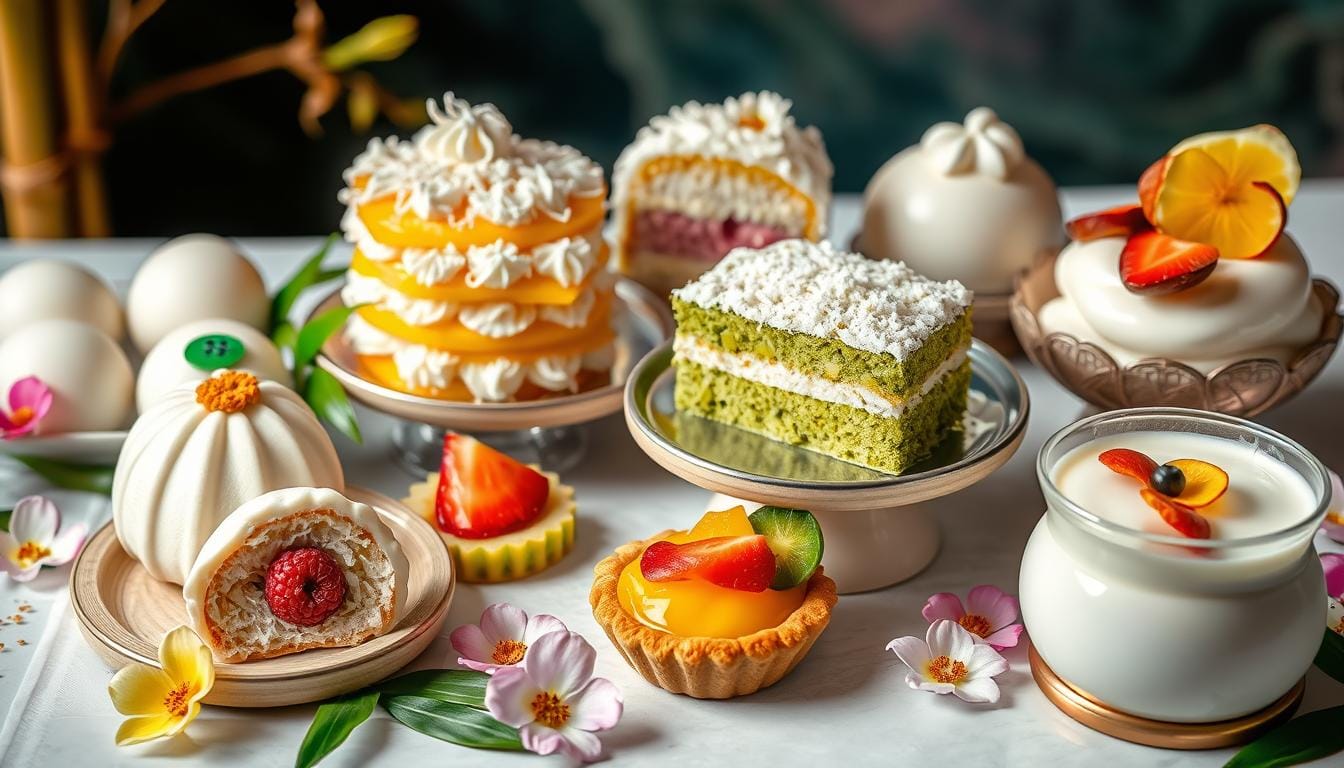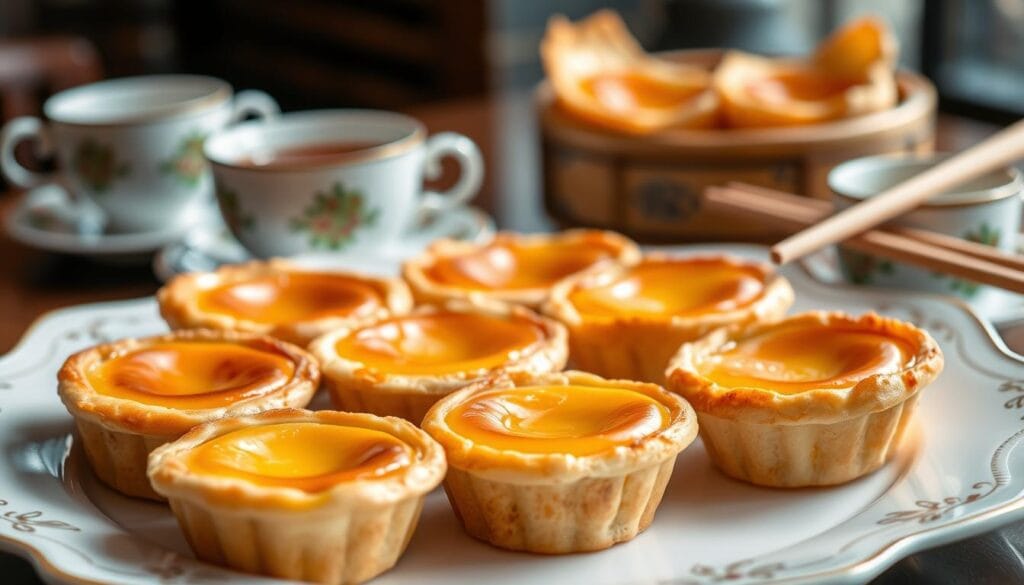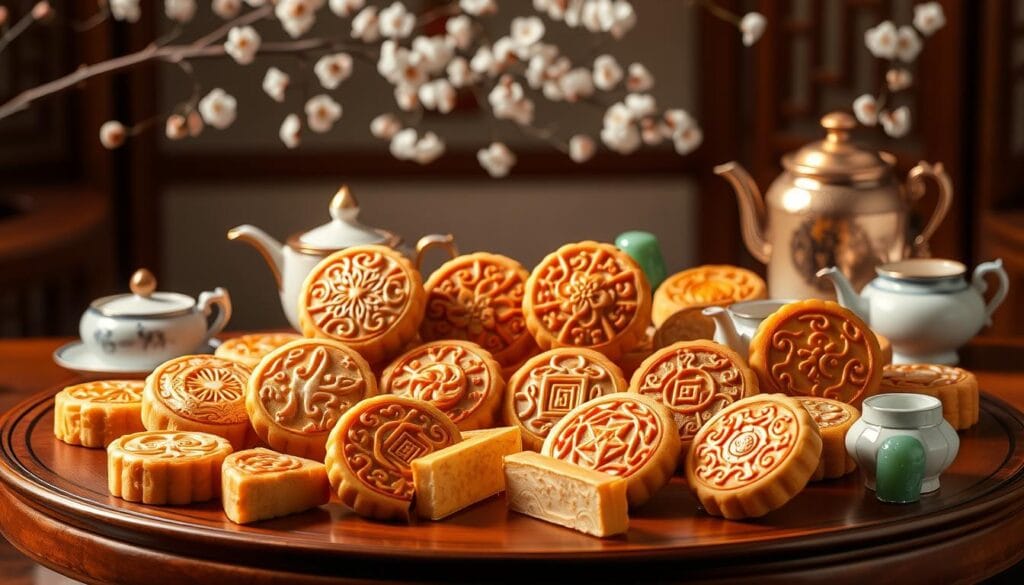As I sat down to savor the layers of delicate mochi, the flavors of East Asia came alive on my palate. The chewy, pillowy texture and subtle sweetness took me on a culinary journey. It was a journey that felt like traveling thousands of miles away.
This is the magic of Asian desserts. They not only delight our senses but also share the stories of diverse cultures and traditions.
In this article, we’ll explore 10 of the most beloved asian desserts that have captured the hearts of sweet tooth enthusiasts worldwide. These sweet treats from the East showcase a vibrant array of flavors, textures, and cultural significance. They invite you to embark on a delectable adventure through Asia’s diverse culinary landscape.
Whether you’re a seasoned connoisseur or new to eastern delicacies, this guide will introduce you to irresistible desserts. These desserts will leave you craving more. So, let’s dive in and uncover the unique and mouthwatering wonders of asian desserts.
Introduction to Asian Desserts
The world of Asian desserts is rich and varied, offering more than just Western sweets. These treats give us a peek into the East’s cultural heritage and traditions. From Japan’s chewy mochi to Southeast Asia’s fragrant pandan cakes, each dessert has its own story.
The Cultural Significance of Sweets
In many Asian cultures, desserts are more than just treats. They’re tied to festivals, celebrations, and rituals. Making and eating these sweets is part of family and community traditions. Ingredients like red bean paste, glutinous rice, and coconut milk give desserts their unique taste and show the region’s connection to nature.
Key Ingredients Used in Asian Desserts
- Glutinous rice: A staple ingredient in many Asian desserts, adding a chewy, sticky texture.
- Red bean paste: A versatile filling used in a variety of sweets, ranging from mochi to mooncakes.
- Coconut milk: Lending a rich, creamy texture and subtle sweetness to desserts across Southeast Asia.
- Pandan leaves: Imparting a distinctive fragrance and vibrant green hue to desserts like pandan chiffon cake.
- Black sesame: Valued for its nutty flavor and striking visual appeal in dishes such as black sesame ice cream.
Traditional ingredients and new methods have created a world of Asian desserts. These desserts amaze our senses and take us on a journey across the continent.
“The true essence of Asian desserts lies in their ability to balance sweetness with complexity, creating a harmonious interplay of flavors and textures that is both familiar and exotic.”
Mochi: A Chewy Japanese Delight
Mochi, the iconic Japanese dessert, has delighted people for over a thousand years. Cooks make it using short-grain mochigome rice. People all over the world love its sticky texture and delicious taste.
From its traditional roots to today, mochi offers a world of flavors and textures. It’s a true delight to explore.
Traditional Varieties of Mochi
Making mochi is a big part of Japanese culture. The traditional ceremony, mochitsuki, involves pounding steamed rice with big wooden mallets. This creates the sticky dough that makes mochi special.
- Daifuku is a favorite, filled with sweet anko (red bean paste). It’s a mix of chewy and smooth.
- Sakura Mochi is a seasonal treat. It’s pink mochi wrapped in a pickled cherry blossom leaf, celebrating the cherry blossom season.
- Kirimochi is enjoyed in winter. It’s grilled mochi filled with red bean paste, with a crispy outside and gooey inside.
Modern Twists on Mochi Desserts
Thanks to global connections, mochi has changed. Now, you can find mochi ice cream and mochi donuts. These treats are loved worldwide and still keep their traditional charm.
“Mochi has become a canvas for culinary innovation, blending the timeless essence of Japanese desserts with the adventurous spirit of modern confectionery.”
Whether you love the classic daifuku or try new mochi dishes, mochi offers a fun journey. It’s a world of Japanese desserts to discover.
Thai Mango Sticky Rice: A Summer Favorite
Dive into the sweet and creamy world of Thai mango sticky rice. It’s a beloved dessert that captures the essence of summer. This traditional Thai treat features a harmonious blend of steamed glutinous rice, velvety coconut milk, and the vibrant sweetness of ripe mangoes.
Ingredients You’ll Need for asian desserts
- 1 cup glutinous rice
- 1 can (400ml) of coconut cream
- 1/4 cup granulated sugar
- 1/2 teaspoon salt
- 1-2 pieces of ripe mangoes
- 1/2 teaspoon cornstarch dissolved in 1 teaspoon of water
How to Prepare Mango Sticky Rice
Indulge in the flavors of Thailand with this easy-to-follow recipe for mango sticky rice. First, soak the glutinous rice in water for at least 30 minutes, then steam it until tender. In a separate saucepan, combine the coconut cream, sugar, and salt, heating them until the sugar dissolves.
Pour this creamy coconut mixture over the cooked rice and gently mix to coat the grains evenly. To add a touch of elegance, top the mango sticky rice with sliced ripe mangoes. For an extra-smooth texture, you can also stir in the cornstarch-water mixture, which will help to thicken the coconut sauce.
Serve this vibrant and flavorful dessert chilled or at room temperature. Savor the perfect balance of sweet, creamy, and tropical flavors.
“Mango sticky rice is a true taste of Thailand, a delightful fusion of contrasting textures and flavors that transports you to the heart of Southeast Asia.”
Hong Kong Egg Tarts: A Flaky Delight
Hong Kong egg tarts are a favorite among locals and visitors. These small, flaky tarts are filled with a creamy, sweet egg custard. This mix of textures and flavors is loved by many.
They are thought to blend British egg custard with Portuguese pastéis de nata. This blend has made the Hong Kong egg tart a symbol of the city’s food culture.
History of the Egg Tart – asian desserts
The Hong Kong egg tart’s story began in the 1920s. The British brought custard tarts to Guangzhou then. Over time, it evolved to become the Hong Kong egg tart we enjoy today.
The recipe includes a buttery pastry shell and a custard made of eggs, sugar, and evaporated milk.
Variations Across Regions
- In Macau, egg tarts have a crispier shell and a caramelized top. This adds a nice contrast to the creamy inside.
- Shortcrust and puff pastry versions are common in Hong Kong. They offer different textures and flakiness.
- Despite their fame, making Hong Kong egg tarts at home is rare. It’s a complex process that requires skill.
Trying a classic Hong Kong egg tart or its regional versions is a must. These flaky, sweet treats are a highlight for anyone visiting or loving pastry. With their rich history and lasting appeal, Hong Kong egg tarts are a true Hong Kong dessert treasure.
Filipino Halo-Halo: A Bowl of Flavor
Halo-Halo is a favorite Filipino dessert. It’s a mix of sweet ingredients that makes it special. Each part adds its own taste and texture, making it a unique treat.
Essential Ingredients for Halo-Halo
The secret to great halo-halo is in the ingredients. It has sweetened chickpeas, red and white mung beans, and candied palm seeds. It also has macapuno, jackfruit, saba bananas, coconut jellies, tapioca pearls, and sweet potato cubes. All these sit on top of shaved ice.
How to Enjoy Halo-Halo Properly
To enjoy halo-halo right, use two tall glasses. Start with shaved ice at the bottom. Then, layer the sweet ingredients on top. This makes it look and feel amazing.
Use a long spoon to mix everything together. This way, every bite is a mix of flavors and textures.
For a dairy-free version, use coconut milk instead of evaporated milk. Heat it with sugar and dark brown sugar until it’s smooth. This keeps the halo-halo taste without dairy.
Halo-Halo is a favorite in the Philippines, enjoyed all year. It’s also getting popular in the West as a cool treat. It started in the late 19th century with Japanese settlers introducing “mong-ya” to the Philippines.
The real magic of halo-halo is in the “mix-mix” part. It’s where all the flavors and textures come together. This creates a memorable taste experience.
Chinese Mooncakes: Seasonal Treats
As the Mid-Autumn Festival nears, the mooncake becomes a star. These traditional Chinese desserts have been a key part of the celebration for centuries. They offer a delightful way to connect with the rich cultural heritage of the East.
Types of Mooncakes and Their Fillings
Mooncakes vary in shape, size, and filling, showing the diverse culinary traditions of China. The most common fillings include:
- Lotus Seed Paste: A classic filling made from ground lotus seeds, often with the addition of salted egg yolks.
- Red Bean Paste: A sweet and creamy paste made from red adzuki beans.
- Durian: For the adventurous, mooncakes filled with the rich, creamy, and fragrant durian fruit.
- Sesame: A nutty and slightly sweet filling made from ground sesame seeds.
Recently, there’s been a move towards healthier options. Now, you can find snow-skin mooncakes and ice-cream mooncakes, catering to modern tastes and dietary needs.
The Tradition of Mooncake Giving
Mooncakes are more than just a tasty treat; they hold deep cultural significance. During the Mid-Autumn Festival, families come together to share mooncakes and admire the full moon. Giving mooncakes to loved ones symbolizes unity, harmony, and the renewal of relationships.
Traditionally, mooncake boxes have four large mooncakes, representing wholeness and completeness. Families split a single mooncake into six or eight pieces, highlighting the importance of unity and sharing.
As the Mid-Autumn Festival draws near, the scent of freshly baked mooncakes fills the air. It reminds us of the rich traditions and sweet delights that make this time of year special in the Chinese desserts world.
Korean Bingsu: Shaved Ice Sensation
Bingsu, a favorite Korean dessert, has won the hearts of many worldwide. This cool shaved ice treat shows the lively and creative food scene in South Korea.
Popular Variants of Bingsu
Modern bingsu goes beyond the classic red beans. You can find mango, green tea, chocolate, banana, strawberry, and melon flavors. These new tastes show how versatile bingsu can be, pleasing many palates.
Tips for Making Bingsu at Home
Making bingsu at home is simple. Freeze lightly whipped milk in tubes for a fluffy texture. Then, shave it and top it with sweetened condensed milk, fruits, buttermilk ice cream, and almonds. Serving it in a hollowed-out melon makes it even more appealing.
Enjoying a mango bingsu or a traditional red bean one is a treat. Bingsu is perfect for hot summer days. It’s a refreshing and sweet delight that stands out among Korean desserts.
“Bingsu is a sizable dessert, often suitable for sharing between two people, making it a delightful social experience.”
Indian Gulab Jamun: Sweet, Syrupy Balls
Gulab Jamun is a favorite Indian dessert. It’s soft, spongy balls made from milk solids, dipped in a sweet syrup. It’s a big hit on special days and celebrations in India.
Ingredients and Preparation Steps
To make perfect Gulab Jamun, you need a few things. The dough mixes powdered milk, all-purpose flour, and baking soda with melted butter. Then, small balls are fried in vegetable oil until they’re golden.
The syrup is what makes Gulab Jamun so tasty. It’s made with sugar, water, cardamom pods, and saffron threads. This syrup is fragrant and rose-scented. The fried balls soak up this sweet, aromatic liquid.
Cultural Occasions for Serving Gulab Jamun
Gulab Jamun is a favorite Indian dessert for big events. It’s enjoyed at festivals like Diwali and Holi, and at weddings and birthdays. These syrupy balls add joy and sweetness to any celebration.
Enjoying Gulab Jamun on its own or with ice cream shows India’s rich culinary heritage. Its timeless charm and ability to bring back memories make it a dessert loved by many.
Vietnamese Che: Colorful Dessert Soups
In Vietnam, che is a standout dessert category. It includes sweet treats in liquid form, from refreshing drinks to rich puddings. These colorful desserts highlight Vietnam’s rich heritage and diverse flavors.
Types of Che and Their Ingredients
Che in Vietnam comes in many forms. Chè Ba Màu is a sweet soup with lychee, jackfruit, and jellies, topped with coconut milk. It’s known for its tri-color look. Chè Bưởi is another favorite, a pomelo sweet soup with sugar, tapioca, and coconut milk.
The ingredients in che vary widely. You’ll find mung beans, red beans, sweet potatoes, taro, seaweed, and tropical fruits like lychee and jackfruit. These are chosen for their textures and flavors.
Serving Suggestions for Che
Che can be enjoyed hot or cold, making it perfect for any time. It’s often served as a refreshing dessert or a soothing treat after meals. The colorful, layered presentation of these Vietnamese desserts is truly captivating.
Looking for a cool treat on a warm day or a comforting dessert? Che offers a journey through Vietnamese dessert soups and their cultural heritage.
Japanese Dorayaki: Pancakes with a Twist
Dorayaki is a special Japanese dessert that’s different from regular pancakes. It has two soft patties with a tasty filling, often red bean paste. But, you can also find dorayaki with custard cream, matcha, or chestnut paste.
Filling Options for Dorayaki
Dorayaki is known for its many fillings. You can choose from:
- Custard Cream – A creamy custard that makes dorayaki extra special.
- Matcha Cream – Matcha powder gives a unique and beautiful flavor.
- Chestnut Paste – A nutty and sweet paste that contrasts well with the pancakes.
How to Make Dorayaki at Home
Making dorayaki at home is fun and rewarding. You’ll need flour, baking powder, sugar, eggs, honey, and your chosen filling. Here’s how to make it:
- Mix the dry ingredients: Combine flour and baking powder in a bowl.
- Whisk the wet ingredients: Whisk eggs, sugar, and honey until they’re light and fluffy.
- Combine the mixtures: Fold the dry ingredients into the wet ingredients until smooth.
- Cook the pancakes: Heat a non-stick pan and cook the batter, flipping once, to make the layers.
- Assemble the dorayaki: Place your chosen filling, like anko or matcha cream, between the layers.
Enjoy your homemade dorayaki with a hot cup of matcha or green tea for a true Japanese treat.
Conclusion: The Sweet Journey Through Asia
Asian desserts are a fascinating journey into different flavors and traditions. From Japan’s mochi to India’s gulab jamun, each dessert tells a story of its country’s heritage. Exploring these sweets is a great way to learn about Asian cultures.
Exploring More Asian Desserts
There’s so much more to Asian desserts than what we’ve covered. You’ll find treasures like Filipino halo-halo, Hong Kong egg tarts, and Korean bingsu. Each one showcases the creativity of its makers, making them a joy to try.
Encouragement to Try Making These Delights
You can make many of these desserts at home and begin your own culinary journey. Try using ingredients like pandan, coconut milk, and palm sugar to bring Asia’s flavors to your kitchen. It’s a fun way to learn new recipes and connect with different cultures.
FAQ
What are some popular Asian desserts?
Popular Asian desserts include mochi, mango sticky rice, and Hong Kong egg tarts. Halo-halo, mooncakes, and bingsu are also favorites. Gulab jamun and Vietnamese che are also loved.
What are the key ingredients commonly used in Asian desserts?
Asian desserts often use glutinous rice, red bean paste, and coconut milk. Fresh fruits are also common.
How is mochi traditionally made?
Mochi is made by steaming and pounding rice. This process gives it a chewy texture.
What are the main components of mango sticky rice?
Mango sticky rice has steamed glutinous rice, sweet coconut milk, and ripe mango slices.
What is the history behind Hong Kong egg tarts?
Hong Kong egg tarts mix British egg custard with Portuguese pastéis de nata. This shows the region’s colonial history.
How is halo-halo typically prepared?
Halo-halo is a Filipino dessert with crushed ice, sweet beans, fruits, and coconut pieces. It’s topped with ice cream.
What are the traditional fillings for mooncakes?
Mooncakes traditionally have lotus paste filling. But, modern ones also have red beans, fruit, and chocolate.
What are the common toppings and flavors found in bingsu?
Bingsu can have red beans or modern flavors like fruits, condensed milk, and syrup. It also has ice cream and yogurt.
How is Gulab Jamun Made?
To make gulab jamun, you combine milk solids, shape them into balls, deep-fry them until golden, and then soak them in sugar syrup. You flavor the syrup with cardamom, rose water, or saffron.
What Ingredients Are Used to Make Vietnamese Che?
Vietnamese che features a mix of lychee, jackfruit, and jellies, served with cold coconut milk. Some recipes also include food coloring to enhance the dessert’s appearance.
What is the filling typically used in dorayaki?
Dorayaki’s filling is usually anko (red bean paste). But, it can also have custard cream, matcha cream, or chestnut paste.



